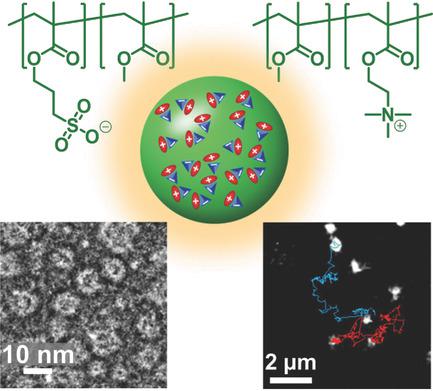当前位置:
X-MOL 学术
›
Adv. Funct. Mater.
›
论文详情
Our official English website, www.x-mol.net, welcomes your
feedback! (Note: you will need to create a separate account there.)
Protein‐Sized Dye‐Loaded Polymer Nanoparticles for Free Particle Diffusion in Cytosol
Advanced Functional Materials ( IF 18.5 ) Pub Date : 2018-10-11 , DOI: 10.1002/adfm.201805157 Andreas Reisch 1 , Doriane Heimburger 1 , Pauline Ernst 1 , Anne Runser 1 , Pascal Didier 1 , Denis Dujardin 1 , Andrey S. Klymchenko 1
Advanced Functional Materials ( IF 18.5 ) Pub Date : 2018-10-11 , DOI: 10.1002/adfm.201805157 Andreas Reisch 1 , Doriane Heimburger 1 , Pauline Ernst 1 , Anne Runser 1 , Pascal Didier 1 , Denis Dujardin 1 , Andrey S. Klymchenko 1
Affiliation

|
How small should nanoparticles be in order to travel freely through the cytosol similar to proteins? Answering this question remains a challenge, because the majority of nanoparticles are relatively large and their size cannot be finely tuned to match that of proteins. Here, poly(methyl methacrylate) copolymers with varied fraction and type of charged groups (carboxylate, sulfonate, and trimethylammonium) are developed, yielding nanoparticles with controlled sizes from 50 to 7 nm through nanoprecipitation. Loading these nanoparticles with a rhodamine dye/bulky counterion pair at 10wt% makes them highly fluorescent. After their coating with polyethylene glycol groups for preventing non‐specific protein binding and microinjection into living cells, the first systematic study of the size effect on diffusion in the cytosol for solid nanoparticles of the same nature is realized. Single‐particle‐tracking data provide evidence for distinct particle sieving in the cytosol, suggesting that only nanoparticles below a critical size of 23 nm exhibit free diffusion and spreading. These findings show the size limitations imposed by intracellular crowding and compartmentalization, which is critical for applications of nanomaterials in the cytosol. The proposed concept of polymer design opens the route to organic nanoparticles of ultrasmall sizes and high loading for bioimaging and drug‐delivery applications.
中文翻译:

蛋白质染料负载的聚合物纳米颗粒可在细胞溶胶中自由扩散。
纳米粒子应该有多小,才能像蛋白质一样自由地通过胞质溶胶?回答这个问题仍然是一个挑战,因为大多数纳米粒子相对较大,并且其大小无法进行微调以匹配蛋白质的大小。在此,开发了具有不同分数和带电基团(羧酸根,磺酸根和三甲基铵)类型的聚(甲基丙烯酸甲酯)共聚物,通过纳米沉淀,可制得尺寸从50到7 nm的纳米颗粒。用10wt%的若丹明染料/大体积抗衡离子对加载这些纳米粒子,使其具有很高的荧光性。在用聚乙二醇基团包被以防止非特异性蛋白质结合和向活细胞显微注射后,对于具有相同性质的固体纳米颗粒,实现了对尺寸大小对细胞质中扩散的影响的第一个系统研究。单颗粒跟踪数据提供了在细胞溶胶中进行独特筛分的证据,这表明只有低于23 nm临界尺寸的纳米颗粒才会表现出自由扩散和扩散。这些发现显示了细胞内拥挤和区室化所施加的尺寸限制,这对于将纳米材料应用于细胞质中至关重要。提出的聚合物设计概念为生物成像和药物输送应用打开了超小尺寸和高载量有机纳米颗粒的途径。这表明只有低于23 nm临界尺寸的纳米颗粒才会显示出自由扩散和扩散。这些发现显示了细胞内拥挤和区室化所施加的尺寸限制,这对于将纳米材料应用于细胞质中至关重要。提出的聚合物设计概念为生物成像和药物输送应用打开了超小尺寸和高载量有机纳米颗粒的途径。这表明只有低于23 nm的临界尺寸的纳米颗粒才会显示出自由扩散和扩散。这些发现显示了细胞内拥挤和区室化所施加的尺寸限制,这对于将纳米材料应用于细胞质中至关重要。提出的聚合物设计概念为生物成像和药物输送应用打开了超小尺寸和高载量有机纳米颗粒的途径。
更新日期:2018-10-11
中文翻译:

蛋白质染料负载的聚合物纳米颗粒可在细胞溶胶中自由扩散。
纳米粒子应该有多小,才能像蛋白质一样自由地通过胞质溶胶?回答这个问题仍然是一个挑战,因为大多数纳米粒子相对较大,并且其大小无法进行微调以匹配蛋白质的大小。在此,开发了具有不同分数和带电基团(羧酸根,磺酸根和三甲基铵)类型的聚(甲基丙烯酸甲酯)共聚物,通过纳米沉淀,可制得尺寸从50到7 nm的纳米颗粒。用10wt%的若丹明染料/大体积抗衡离子对加载这些纳米粒子,使其具有很高的荧光性。在用聚乙二醇基团包被以防止非特异性蛋白质结合和向活细胞显微注射后,对于具有相同性质的固体纳米颗粒,实现了对尺寸大小对细胞质中扩散的影响的第一个系统研究。单颗粒跟踪数据提供了在细胞溶胶中进行独特筛分的证据,这表明只有低于23 nm临界尺寸的纳米颗粒才会表现出自由扩散和扩散。这些发现显示了细胞内拥挤和区室化所施加的尺寸限制,这对于将纳米材料应用于细胞质中至关重要。提出的聚合物设计概念为生物成像和药物输送应用打开了超小尺寸和高载量有机纳米颗粒的途径。这表明只有低于23 nm临界尺寸的纳米颗粒才会显示出自由扩散和扩散。这些发现显示了细胞内拥挤和区室化所施加的尺寸限制,这对于将纳米材料应用于细胞质中至关重要。提出的聚合物设计概念为生物成像和药物输送应用打开了超小尺寸和高载量有机纳米颗粒的途径。这表明只有低于23 nm的临界尺寸的纳米颗粒才会显示出自由扩散和扩散。这些发现显示了细胞内拥挤和区室化所施加的尺寸限制,这对于将纳米材料应用于细胞质中至关重要。提出的聚合物设计概念为生物成像和药物输送应用打开了超小尺寸和高载量有机纳米颗粒的途径。











































 京公网安备 11010802027423号
京公网安备 11010802027423号